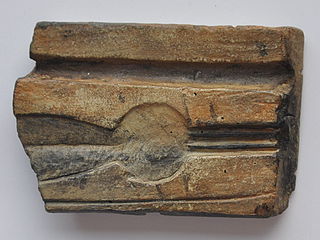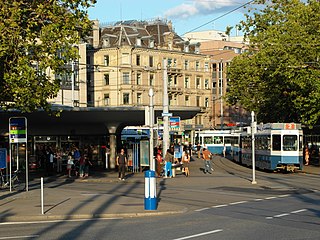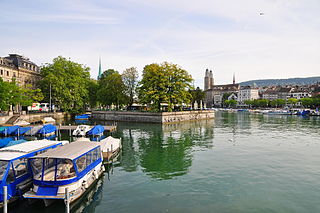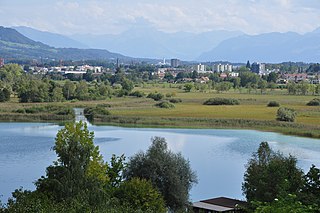
Lake Zurich is a lake in Switzerland, extending southeast of the city of Zurich. Depending on the context, Lake Zurich or Zürichsee can be used to describe the lake as a whole, or just that part of the lake downstream of the Hurden peninsula and Seedamm causeway. In the latter case, the upstream part of the lake is called Obersee, whilst the lower part is sometimes also referred to as the Lower Lake, respectively.

The Limmat is a river in Switzerland. The river commences at the outfall of Lake Zurich, in the southern part of the city of Zürich. From Zürich it flows in a northwesterly direction, continuing a further 35 km until it reaches the river Aare. The confluence is located north of the small town of Brugg and shortly after the mouth of the Reuss.

Enge is a quarter in District 2 of Zürich, Switzerland.

Prehistoric pile dwellings around the Alps are a series of prehistoric pile dwelling settlements in and around the Alps built from about 5000 to 500 BC on the edges of lakes, rivers or wetlands. In 2011, 111 sites located variously in Switzerland (56), Italy (19), Germany (18), France (11), Austria (5) and Slovenia (2) were added to the UNESCO World Heritage Site list. In Slovenia, these were the first World Heritage Sites to be listed for their cultural value.

Turicum was a Gallo-Roman settlement at the lower end of Lake Zurich, and precursor of the city of Zurich. It was situated within the Roman province of Germania Superior) and near the border to the province of Raetia; there was a tax-collecting point for goods traffic on the waterway Walensee–Obersee-Zürichsee–Limmat–Aare–Rhine.

Robenhausen is a locality in Wetzikon, one of the municipalities of the canton of Zürich, Switzerland. The wetland Robenhauser Ried belongs to the protected area surrounding Pfäffikersee. The prehistoric pile dwelling around Lake Zurich Wetzikon-Robenhausen is part of the UNESCO-defined World Heritage Sites, the prehistoric pile dwellings around the Alps.

Kleiner Hafner is one of the 111 serial sites of the UNESCO World Heritage Site Prehistoric pile dwellings around the Alps, of which are 56 located in Switzerland.

Grossner Hafner is one of the 111 serial sites of the UNESCO World Heritage Site Prehistoric pile dwellings around the Alps, of which are 56 located in Switzerland.

Prehistoric pile dwellings around Lake Zurich are pile dwelling sites located around Lake Zurich in the cantons of Schwyz, St. Gallen and Zurich.

Freienbach–Hurden Rosshorn, more often called Hurden Rosshorn or simply Rosshorn, is one of the 111 serial sites of the UNESCO World Heritage Prehistoric pile dwellings around the Alps, of which are 56 located in Switzerland. The Rosshorn site is exceptional because it doesn't contain remains of a prehistoric settlement but instead remains of prehistoric and historic bridges that were built in a shallow area of Lake Zurich.

Rapperswil-Jona/Hombrechtikon–Feldbach is one of the 111 serial sites of the UNESCO World Heritage Site Prehistoric pile dwellings around the Alps, of which are 56 located in Switzerland.

Rapperswil-Jona–Technikum is one of the 111 serial sites of the UNESCO World Heritage Site Prehistoric pile dwellings around the Alps, of which are 56 located in Switzerland. It is a small former island in the upper Lake Zürich in Rapperswil, a locality of the municipality of Rapperswil-Jona in the Canton of St. Gallen.

Greifensee–Storen–Wildsberg is one of the 111 serial sites of the UNESCO World Heritage Site Prehistoric pile dwellings around the Alps, of which are 56 located in Switzerland.

Meilen–Rorenhaab is one of the 111 serial sites of the UNESCO World Heritage Site Prehistoric pile dwellings around the Alps, of which 56 are located in Switzerland.

Zürich–Enge Alpenquai is one of the 111 serial sites of the UNESCO World Heritage Site Prehistoric pile dwellings around the Alps, of which 56 are located in Switzerland.

Wädenswil–Vorder Au is one of the 111 serial sites of the UNESCO World Heritage Site Prehistoric pile dwellings around the Alps, of which 56 are located in Switzerland.

Bellevueplatz is a town square in Zurich, Switzerland built in 1856. Named after the former Grandhotel Bellevue on its north side, it is one of the nodal points for roads and public transportation in Zurich, as well as an extension of the quaysides in Zurich that were built between 1881 and 1887. It is part of the Altstadt district.

Bürkliplatz is a town square in Zurich, Switzerland. It is named after Arnold Bürkli, and is one of nodal points of the road and public transportation, and of the lake shore promenades that were built between 1881 and 1887. The tree-shaded square between Bahnhofstrasse and Fraumünsterstrasse is called Stadthausanlage.

Bauschänzli is an artificial island, town square, and public park in Zürich, Switzerland. Bauschänzli is one of the last remains of the Baroque fortifications of Zürich which began in 1642. The neighboring Schanzengraben (moat) and the Old Botanical Garden are part of these remains. Since 1907, the island has been used as a restaurant, although it is officially a public square and park.

Wetzikon–Robenhausen is one of the 111 serial sites of the UNESCO World Heritage Site Prehistoric pile dwellings around the Alps, of which are 56 located in Switzerland. The site is located on Pfäffikersee lakeshore in Robenhausen, a locality of the municipality of Wetzikon in the Canton of Zürich in Switzerland.











































